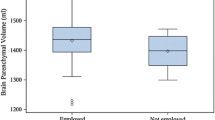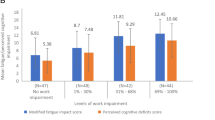Abstract
Multiple sclerosis (MS) is associated with significant economic burden and high rates of unemployment. This investigation evaluated patient and disease characteristics associated with work loss and work initiation using the NARCOMS patient registry. Patient and disease characteristics associated with transitions to unemployment or employment were evaluated cross-sectionally and prospectively over the course of two assessment periods (mean interval of 1.56 ± 0.93 years). Eligible participants included 8,867 patients for the cross-sectional component, and 8,122 for longitudinal analyses. At Time 1 and Time 2 56–58 % of MS patients were not employed. At Time 1, unemployed participants more likely to have a progressive disease course, had a longer symptom duration, greater levels of disability as measured by the PDDS, and greater functional limitations across all domains of the performance scales (p < 0.0001 for all). At Time 2, increasing MS symptoms in the past 6 months increased the odds of becoming unemployed. In addition, specific problems in mobility, hand function, fatigue, and cognitive performance domains were associated with increased odds of becoming unemployed. Less severe problems in similar areas, including mobility, hand function, and cognitive functioning were also predictive of work initiation among patients not employed. MS is associated with high rates of unemployment. Specific physical and mental health limitations confer risk of employment cessation over time, as well as the likelihood of employment initiation. This study has implications for rehabilitation interventions to target specific MS related limitations that place patients at greatest risk for work status changes.
Similar content being viewed by others
References
Ariel M, Sara D (2006) Health-related quality of life in multiple sclerosis: the impact of disability, gender and employment status. Qual Life Res V15:259–271
Bauer HJ, Firnhaber W, Winkler W (1965) Prognostic criteria in multiple sclerosis. Ann N Y Acad Sci 122:542–551
Beatty W, Blanco C, Wilbanks S, Paul R, Hames K (1995) Demographic, clinical and cognitive characteristics of multiple sclerosis patients who continue to work. J Neurol Rehabil 9:167–173
Beatty WW, Blanco CR, Wilbanks BS, Paul RH, Hames BA (1995) Demographic, clinical, and cognitive characteristics of multiple sclerosis patients who continue to work. J Neurol Rehabil 9:167–173
Beatty WW, Blanco CR, Wilbanks SL, Paul RH, Hames KA (1995) Demographic, clinical, and cognitive characteristics of multiple sclerosis patients who continue to work. J Neurol Rehabil 9:167–173
Busche KD, Fisk JD, Murray TJ, Metz LM (2003) Short term predictors of unemployment in multiple sclerosis patients. Can J Neurol Sci 30:137–142
Canadian Burden of Illness Group (1998) Burden of illness of multiple sclerosis: part II: quality of life. Can J Neurol Sci 25:31–38
de Croon EM, Sluiter JK, Nijssen TF, Dijkmans BAC, Lankhorst GJ, Frings- Dresen MHW (2004) Predictive factors of work disability in rheumatoid arthritis: a systematic literature review. Ann Rheum Dis 63:1362–1367
Edgley K, Sullivan M, Dehoux E (1991) A survey of multiple sclerosis: determinants of employment status. Can J Rehabil 4:127–132
Freal JE, Kraft GH, Coryell JK (1984) Symptomatic fatigue in multiple sclerosis. Arch Phys Med Rehabil 65:135–138
Genevie L, Kallos JE, Struening EL (1987) Job retention among people with MS. J Neurol Rehabil 1:131–135
Grima DT, Torrance GW, Francis G, Rice G, Rosner AJ, Lafortune L (2000) Cost and health related quality of life consequences of multiple sclerosis. Mult Scler 6:91–98
Gronning M, Hannisdal E, Mellgren SI (1990) Multivariate analyses of factors associated with unemployment in people with multiple sclerosis. J Neurol Neurosurg Psychiatry 53:388–390
Hadjimichael O, Kerns RD, Rizzo MA, Cutter G, Vollmer T (2007) Persistent pain and uncomfortable sensations in persons with multiple sclerosis. Pain 127(1–2):35–41
Hammond SR, McLeod JG, Macaskill P, English DR (1996) Multiple sclerosis in Australia: socioeconomic factors. J Neurol Neurosurg Psychiatry 61:311–313
Jackson MF, Quaal C, Reeves MA (1991) Effects of multiple sclerosis on occupational and career patterns. Axone 13:16–17, 20–12
Jacobs LD, Wende KE, Brownscheidle CM, Apatoff B, Coyle PK, Goodman A, Gottesman MH, Granger CV, Greenberg SJ, Herbert J, Krupp L, Lava NS, Mihai C, Miller AE, Perel A, Smith CR, Snyder DH (1999) A profile of multiple sclerosis: the New York State Multiple Sclerosis Consortium. Mult Scler 5:369–376
Julian L, Merluzzi NM, Mohr DC (2007) The relationship among depression, subjective cognitive impairment, and neuropsychological performance in multiple sclerosis. Mult Scler 13:81–86
Kornblith AB, La Rocca NG, Baum HM (1986) Employment in individuals with multiple sclerosis. Int J Rehabil Res 9:155–165
Kurtzke JF (1983) Rating neurologic impairment in multiple sclerosis: an expanded disability status scale (EDSS). Neurology 33:1444–1452
Larocca N, Kalb R, Scheinberg L, Kendall P (1985) Factors associated with unemployment of patients with multiple sclerosis. J Chronic Dis 38:203–210
LaRocca N, Kalb R, Scheinberg L, Kendall P (1985) Factors associated with unemployment of patients with multiple sclerosis. J Chronic Dis 38:203–210
Lovera J, Bagert B, Smoot KH, Wild K, Frank R, Bogardus K, Oken BS, Whitham RH, Bourdette DN (2006) Correlations of Perceived Deficits Questionnaire of Multiple Sclerosis Quality of Life Inventory with Beck Depression Inventory and neuropsychological tests. J Rehabil Res Dev 43:73–82
Marrie RA, Chelune GJ, Miller DM, Cohen JA (2005) Subjective cognitive complaints relate to mild impairment of cognition in multiple sclerosis. Mult Scler 11:69–75
Marrie RA, Cutter G, Tyry T, Hadjimichael O, Campagnolo D, Vollmer T (2005) Changes in the ascertainment of multiple sclerosis. Neurology 65:1066–1070
Marrie RA, Cutter G, Tyry T, Vollmer T, Campagnolo D (2006) Does multiple sclerosis-associated disability differ between races? Neurology 66:1235–1240
McCabe MP, De Judicibus M (2003) Multiple sclerosis and economic wellbeing: role of health, age, and duration of illness. J Clin Psychol Med Settings 10:139–147
Midgard R, Riise T, Nyland H (1996) Impairment, disability, and handicap in multiple sclerosis. A cross-sectional study in an incident cohort in More and Romsdal County, Norway. J Neurol 243:337–344
Miller DM, Rudick RA, Cutter G, Baier M, Fischer JS (2000) Clinical significance of the multiple sclerosis functional composite: relationship to patient- reported quality of life. Arch Neurol 57:1319–1324
Mitchell JN (1981) Multiple sclerosis and the prospects for employment. J Soc Occup Med 31:134–138
O’Connor RJ, Cano SJ, Ramio i Torrenta L, Thompson AJ, Playford ED (2005) Factors influencing work retention for people with multiple sclerosis: cross-sectional studies using qualitative and quantitative methods. J Neurol 252:892–896
Patricia AF, Usha S (2004) Employment and Disability: Evidence from the 1996 Medical Expenditures Panel Survey. J Occupational Rehabil V14:1–11
Preiningerova J, Hadjimichael O, Vollmer T, Rizzo MA (2003) Validation of patient-reported disease descriptors in the NARCOMS patient registry. International Journal of MS Care (serial online) 5:126
Rao SM, Leo GJ, Ellington L, Nauertz T, Bernardin L, Unverzagt F (1991) Cognitive dysfunction in multiple sclerosis. II. Impact on employment and social functioning (see comments). Neurology 41:692–696
Rodriguez M, Siva A, Ward J, Stolp- Smith K, O’Brien P, Kurland L (1994) Impairment, disability, and handicap in multiple sclerosis: a populationbased study in Olmsted County, Minnesota. Neurology 44:28–33
Rozin R, Schiff Y, Kahana E, Soffer D (1975) Vocational status of multiple sclerosis patients in Israel. Arch Phys Med Rehabil 56:300–304
Rune M, Trond R, Harald N (1996) Impairment, disability and handicap in multiple sclerosis A cross-sectional study in an incident cohort in Møre and Romsdal County, Norway. J Neurol V243:337–344
Salomone PR, O’Connell KR (1988) The impact of disability on career development of people with multiple sclerosis. Journal of Career Development 25(1):65–81
Schwartz CE, Vollmer T, Lee H (1999) Reliability and validity of two selfreport measures of impairment and disability for MS. North American Research Consortium on Multiple Sclerosis Outcomes Study Group. Neurology 52:63–70
Smith MM, Arnett PA (2005) Factors related to employment status changes in individuals with multiple sclerosis. Mult Scler 11:602–609
Verdier-Taillefer MH, Sazdovitch V, Borgel F, Cesaro P, Kurtz A, Millet MF, Roullet E, Marteau R (1995) Occupational environment as risk factor for unemployment in multiple sclerosis. Acta Neurol Scand 92:59–62
Vollmer T, Ni W, Stanton S, Hadjimichael O (1999) The NARCOMS Patient Registry: a resource for investigators. Int J MS Care (serial online)
Vollmer TL, Hadjimichael O, Preiningerova J, Ni W, Buenconsejo J (2002) Disability and treatment patterns of multiple sclerosis patients in United States: a comparison of veterans and nonveterans. J Rehabil Res Dev 39:163–174
Author information
Authors and Affiliations
Corresponding author
Rights and permissions
About this article
Cite this article
Julian, L.J., Vella, L., Vollmer, T. et al. Employment in multiple sclerosis. J Neurol 255, 1354–1360 (2008). https://doi.org/10.1007/s00415-008-0910-y
Received:
Revised:
Accepted:
Published:
Issue Date:
DOI: https://doi.org/10.1007/s00415-008-0910-y




